Surface Water Change Detection via Water Indices and Predictive Modeling Using Remote Sensing Imagery: A Case Study of Nuntasi-Tuzla Lake, Romania
Abstract
:1. Introduction
2. Materials and Methods
2.1. Study Area
2.2. Data Sets
2.2.1. Hydrological Datasets
2.2.2. Remote Sensing Datasets
2.3. Methods
2.3.1. Hydrological Analysis
2.3.2. RS Analysis
3. Results and Discussion
3.1. Human Intervention
3.2. Hydrological Drought Analysis
3.3. Remote Sensing Analysis
3.3.1. Accuracy Assessment
3.3.2. Seasonal Water Surface Variation
4. Conclusions
- (i)
- In natural conditions, the lake system is connected to the Black Sea via the Portita, Periboina and Edighiol outlets (Figure 2) and with the St George Arm of the Danube River via a system of canals and marshes. The nine lakes which compose the Razim Sinoe System are interconnected by the above mentioned system of canals. Human intervention has led to a deterioration of the ecosystem of the entire Razim Sinoe system, which has been isolated from the Black Sea, and the connections between the lakes have been cut by sluices. In this context, the water became freshwater. The cannal between Nuntasi-Tuzla Lake and Istria Lake has been silted since 1976. In view of the fact that the Dobrogea region is the driest region of Romania [35] and in order to ensure agricultural development, the state authorities from the period 1968–1975 built an important irrigation system in this region. In the irrigation period, the two tributaries (Nuntasi and Sacele rivers) have supplied the lake constantly, but after 1990, when the irrigation was stopped, the river flow decreased over time reaching its lowest level in the 2004 (2007)–2020 period. In a recent publication, the authors [21] showed that “the precipitation increased starting with 2012 but the evapotranspiration losses are much larger than the precipitation increase”. We can conclude that the budget is negative. It is apparent that the surface lake may be a subject of irreversible changes.
- (ii)
- The analysis of the daily flows of the two rivers during the 2007–2020 period detected several important drought events. Among these, two drought periods with long duration were determined, in 2013 and 2020. In this context, we further investigated if there was any influence of flow decreasing on the lake water surface and if there have been any other similar situations in the past.
- (iii)
- Using the CART model with the seasonal averaged values of RS indices (NDVI, NDWI, MNDWI, WNDWI and WRI) as the input data, we assessed the seasonal water lake surface variation during the period 1984–2021 with over 90% mapping accuracy, user accuracy and overall accuracy. The results of the proposed classification method revealed that the evolution of surface lake water is correlated with human intervention and the hydrological drought identified with the TLM method. Significant decrease during the 2003–2020 period was identified in the surface water lake’s evolution, thus the hydrological drought identified in 2011, 2012, 2013 and 2020 corresponds with the lowest values for water lake surface. In our opinion, the method based on remote sensing data and the CART model is calibrated, due to the results obtained. Unfortunately, we have only a short series of daily records, which limits this study.
Author Contributions
Funding
Institutional Review Board Statement
Informed Consent Statement
Data Availability Statement
Conflicts of Interest
References
- Peng, Y.; He, G.; Wang, G.; Cao, H. Surface Water Changes in Dongting Lake from 1975 to 2019 Based on Multisource Remote-Sensing Images. Remote Sens. 2021, 13, 1827. [Google Scholar] [CrossRef]
- Bărbulescu, A.; Dumitriu, C.Ș.; Maftei, C. On the Probable Maximum Precipitation method. Rom. J. Phys. 2022, 67, 801. [Google Scholar]
- Bărbulescu, A.; Postolache, F.; Dumitriu, C.S. Estimating the Precipitation Amount at Regional Scale Using a New Tool, Climate Analyzer. Hydrology 2021, 8, 125. [Google Scholar] [CrossRef]
- Cui, B.-L.; Xiao, B.; Li, X.-Y.; Wang, Q.; Zhang, Z.-H.; Zhan, C. Exploring the geomorphological processes of Qinghai Lake and surrounding lakes in the northeastern Tibetan Plateau, using Multitemporal Landsat Imagery (1973–2015). Glob. Planet. Chang. 2017, 152, 167–175. [Google Scholar] [CrossRef] [Green Version]
- Adrian, R.; O’Reilly, C.M.; Zagarese, H.; Baines, S.B.; Hessen, D.O.; Keller, W.; Livingstone, D.M.; Sommaruga, R.; Straile, D.; van Donk, E.; et al. Lakes as sentinels of climate change. Limnol. Oceanogr. 2009, 54, 2283–2297. [Google Scholar] [CrossRef]
- Maftei, C.; Buta, C.; Carazeanu Popovici, I. The Impact of Human Interventions and Changes in Climate on the Hydro-Chemical Composition of Techirghiol Lake (Romania). Water 2020, 12, 2261. [Google Scholar] [CrossRef]
- Conserving Iran and Iraq’s Wetlands, UNEP. 2018. Available online: http://www.unep.org/news-and-stories/story/conserving-iran-and-iraqs-wetlands (accessed on 16 June 2021).
- Benson, L.V.; Paillet, F.L. The Use of Total Lake-Surface Area as an Indicator of Climatic Change: Examples from the Lahontan Basin. Quat. Res. 1989, 32, 262–275. [Google Scholar] [CrossRef]
- Rouse, W.; Haas, R.H.; Schell, J.A.; Deering, D. Monitoring Vegetation Systems in the Great Plains with ERTs; NASA: Washington, DC, USA, 1974; p. 309. [Google Scholar]
- Peters, A.J.; Walter-Shea, E.A.; Ji, L.; Vliia, A.; Hayes, M.; Svoboda, M.D. Drought Monitoring with NDVI-Based Standardized Vegetation Index. Photogram. Eng. Remote Sens. 2002, 68, 71–75. [Google Scholar]
- Mishra, A.K.; Singh, V.P. A review of drought concepts. J. Hydrol. 2010, 391, 202–216. [Google Scholar] [CrossRef]
- Rokni, K.; Ahmad, A.; Selamat, A.; Hazini, S. Water Feature Extraction and Change Detection Using Multitemporal Landsat Imagery. Remote Sens. 2014, 6, 4173–4189. [Google Scholar] [CrossRef] [Green Version]
- McFeeters, S.K. The use of the Normalized Difference Water Index (NDWI) in the delineation of open water features. Int. J. Remote Sens. 1996, 17, 1425–1432. [Google Scholar] [CrossRef]
- Xu, H. Modification of normalised difference water index (NDWI) to enhance open water features in remotely sensed imagery. Int. J. Remote Sens. 2006, 27, 3025–3033. [Google Scholar] [CrossRef]
- Shen, L.; Li, C. Water body extraction from Landsat ETM+ imagery using adaboost algorithm. In Proceedings of the 2010 18th International Conference on Geoinformatics, Beijing, China, 18–20 June 2010; pp. 1–4. [Google Scholar]
- Guo, Q.; Pu, R.; Li, J.; Cheng, J. A weighted normalized difference water index for water extraction using Landsat imagery. Int. J. Remote Sens. 2017, 38, 5430–5445. [Google Scholar] [CrossRef]
- Acharya, T.D.; Subedi, A.; Yang, I.T.; Lee, D.H. Combining Water Indices for Water and Background Threshold in Landsat Image. Proceedings 2017, 2, 143. [Google Scholar] [CrossRef] [Green Version]
- Acharya, T.D.; Subedi, A.; Lee, D.H. Evaluation of Water Indices for Surface Water Extraction in a Landsat 8 Scene of Nepal. Sensors 2018, 18, 2580. [Google Scholar] [CrossRef] [Green Version]
- Preoteasa, L.; Vespremeanu-Stroe, A.; Hanganu, D.; Katona, A.; Timar-Gabor, A. Coastal changes from open coast to present lagoon system in Histria region (Danube delta). J. Coast. Res. 2013, 65, 564–569. [Google Scholar] [CrossRef]
- Breier, A. Lacurile de pe Litoralul Romanesc al Marii Negre. Studiu Hidrogeografic; Editura Academiei Republicii Socialiste România: București, Romania, 1976. [Google Scholar]
- Maftei, C.; Dobrica, G.; Cerneaga, C.; Buzgaru, N. Drought Land Degradation and Desertification—Case Study of Nuntasi-Tuzla Lake in Romania. In Water Safety, Security and Sustainability: Threat Detection and Mitigation; Vaseashta, A., Maftei, C., Eds.; Springer International Publishing: Cham, Switzerland, 2021; pp. 583–597. [Google Scholar] [CrossRef]
- Breiman, L.; Friedman, J.H.; Olshen, R.A.; Stone, C.J. Classification and Regression Trees; Routledge: Boca Raton, FL, USA, 2017. [Google Scholar] [CrossRef]
- Maftei, C.; Barbulescu, A. Statistical analysis of precipitation time series in the Dobrudja region. Mausam 2012, 63, 553–564. [Google Scholar] [CrossRef]
- Dumitriu, C.S.; Dragomir, F.-L. Modeling the Signals Collected in Cavitation Field by Stochastic and Artificial Intelligence Methods. In Proceedings of the 2021 13th International Conference on Electronics, Computers and Artificial Intelligence (ECAI), Pitesti, Romania, 1–3 July 2021; pp. 1–4. [Google Scholar] [CrossRef]
- Vogt, J.V.; Somma, F. Drought and Drought Mitigation in Europe; Springer: Dordrecht, Netherlands, 2000. [Google Scholar] [CrossRef]
- Fatulová, E.; Majerčáková, O.; Houšková, B.; Bardarska, G.; Alexandrov, V.; Kulířová, P.; Gayer, J.; Molnár, P.; Fiala, K.; Tamás, J.; et al. Guidelines for Preparation of the Drought Management Plans: Development and Implementation of Risk-Based Drought Management Plans in the Context of the EU Water Framework Directive—As Part of the River Basin Management Plans; Global Water Partnership Central and Eastern Europe: Bratislava, Slovakia, 2015. [Google Scholar]
- Smakhtin, V.; Hughes, D.A.; International Water Management Institute. Review, Automated Estimation and Analyses of Drought Indices in South Asia; International Water Management Institute: Colombo, Sri Lanka, 2004. [Google Scholar]
- Tallaksen, L.; van Lanen, H.A.J.; Hydrological Drought. Processes and Estimation Methods for Streamflow and Groundwater. Elsevier. 2004; Available online: https://research.wur.nl/en/publications/hydrological-drought-processes-and-estimation-methods-for-streamf (accessed on 13 August 2021).
- Yevjevich, V.M. An objective approach to definitions and investigations of continental hydrologic droughts. J. Hydrol. 1969, 7, 353. [Google Scholar] [CrossRef] [Green Version]
- Mateo-García, G.; Gómez-Chova, L.; Amorós-López, J.; Muñoz-Marí, J.; Camps-Valls, G. Multitemporal Cloud Masking in the Google Earth Engine. Remote Sens. 2018, 10, 1079. [Google Scholar] [CrossRef] [Green Version]
- Bărbulescu, A.; Dumitriu, C.Ș.; Dragomir, F.L. Detecting Aberrant Values and Their Influence on the Time Series Forecast. In Proceedings of the International Conference on Electrical, Computer, Communications and Mechatronics Engineering (ICECCME), Mauritius, Mauritius, 7–8 October 2021. [Google Scholar] [CrossRef]
- Pencue-Fierro, E.L.; Solano-Correa, Y.T.; Corrales-Mũnoz, J.C.; Figueroa-Casas, A. A Semi-Supervised Hybrid Approach for Multitemporal Multi-Region Multisensor Landsat Data Classification. IEEE J. Sel. Top. Appl. Earth Obs. Remote Sens. 2016, 9, 5424–5435. [Google Scholar] [CrossRef]
- Duan, H.; Deng, Z.; Deng, F.; Wang, D. Assessment of Groundwater Potential Based on Multicriteria Decision Making Model and Decision Tree Algorithms. Math. Probl. Eng. 2016, 1, 2064575. [Google Scholar] [CrossRef] [Green Version]
- Gastescu, P. The Danube Delta: Geographical characteristics and ecological recovery. GeoJournal 1993, 29, 57–67. [Google Scholar] [CrossRef]
- Aurel, L.; Liliana, M. Drought Management in the Agriculture of Dobrogea Province, 2013, 65–70. Available online: https://mpra.ub.uni-muenchen.de/53403/1/MPRA_paper_53403.pdf (accessed on 24 December 2021).
- Grumezea, N.; Kleps, C.; Tusa, C. Evolutia Nivelului si Chimismului Apei Freatice din Amenajarile de Irigatii in Interrelatie cu Mediul Inconjurator; Intreprinderea Poligrafica Oltenia: București, Romania, 1990. [Google Scholar]
- Pons, L.J. Natural resources. In Conservation Status of the Danube Delta; IUCN: Newbury, Berkshire, UK, 1992; Volume 4, pp. 23–36. [Google Scholar]
- Bretcan, P.; Murărescu, O.; Samoilă, E.; Popescu, O. The Modification of the Ecological Conditions in the Razim-Sinoaie Lacuster Complex as an Effect of the Anthropic Intervention. Presented at the XXIVth Conference of the Danubian Countries on the Hydrological Forecasting and Hydrological Bases of Water Management, Bled, Slovenia, 2–4 June 2008. [Google Scholar]
- Vadineanu, A.; Cristofor, S.; Ignat, G.; Romanca, G.; Ciubuc, C.; Florescu, C. Changes and opportunities for integrated management of the Razim-Sinoe Lagoon System. Int. J. Salt Lake Res. 1997, 6, 135–144. [Google Scholar] [CrossRef]
- Bretcan, P.; Murărescu, O.; Samoilă, E.; Popescu, O. Water Management in the Razim—Sinoie Lacustrine Complex. Presented at the International Symposium on Water Management and Hydraulic Engineering, Ohrid/Macedonia, 1–5 September 2009; pp. 791–801. [Google Scholar]
- Turnock, D. Water resource management problems in Romania. GeoJournal 1979, 3, 609–622. [Google Scholar] [CrossRef]
- Proiect de Deabilitare si Reforma a Irigatiilor. Available online: http://old.madr.ro/pages/strategie/proiect-de-reabilitare-si-reforma-a-irigatiilor.pdf (accessed on 13 August 2021).
- Ministerul Agriculturii şi Dezvoltării Rurale. Strategia Națională de Reabilitare și Extindere a Infrastructurii de Irigaţii din România. 2019. Available online: https://www.madr.ro/download (accessed on 13 August 2021).
- Rusu, G. Sinteza Cercetarilor in Perioada 1975–1982 Pentru Lacurile Techirghiol, Nuntasi si Istria; ICPGA: Bucuresti, Romania, 1982. [Google Scholar]
- Foody, G.M. Status of Land Cover Classification Accuracy Assessment. Remote Sens. Environ. 2002, 80, 185–201. [Google Scholar] [CrossRef]
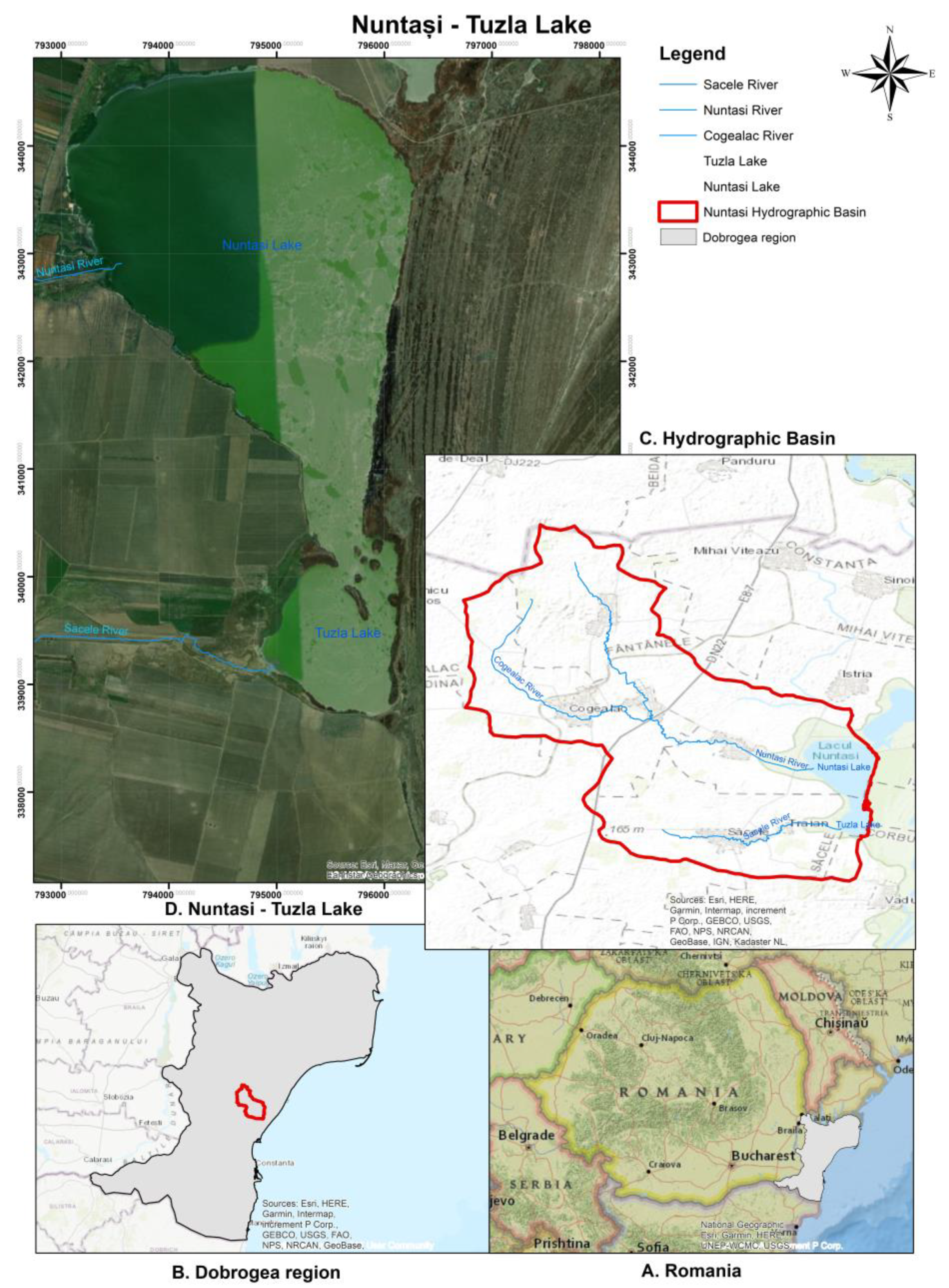
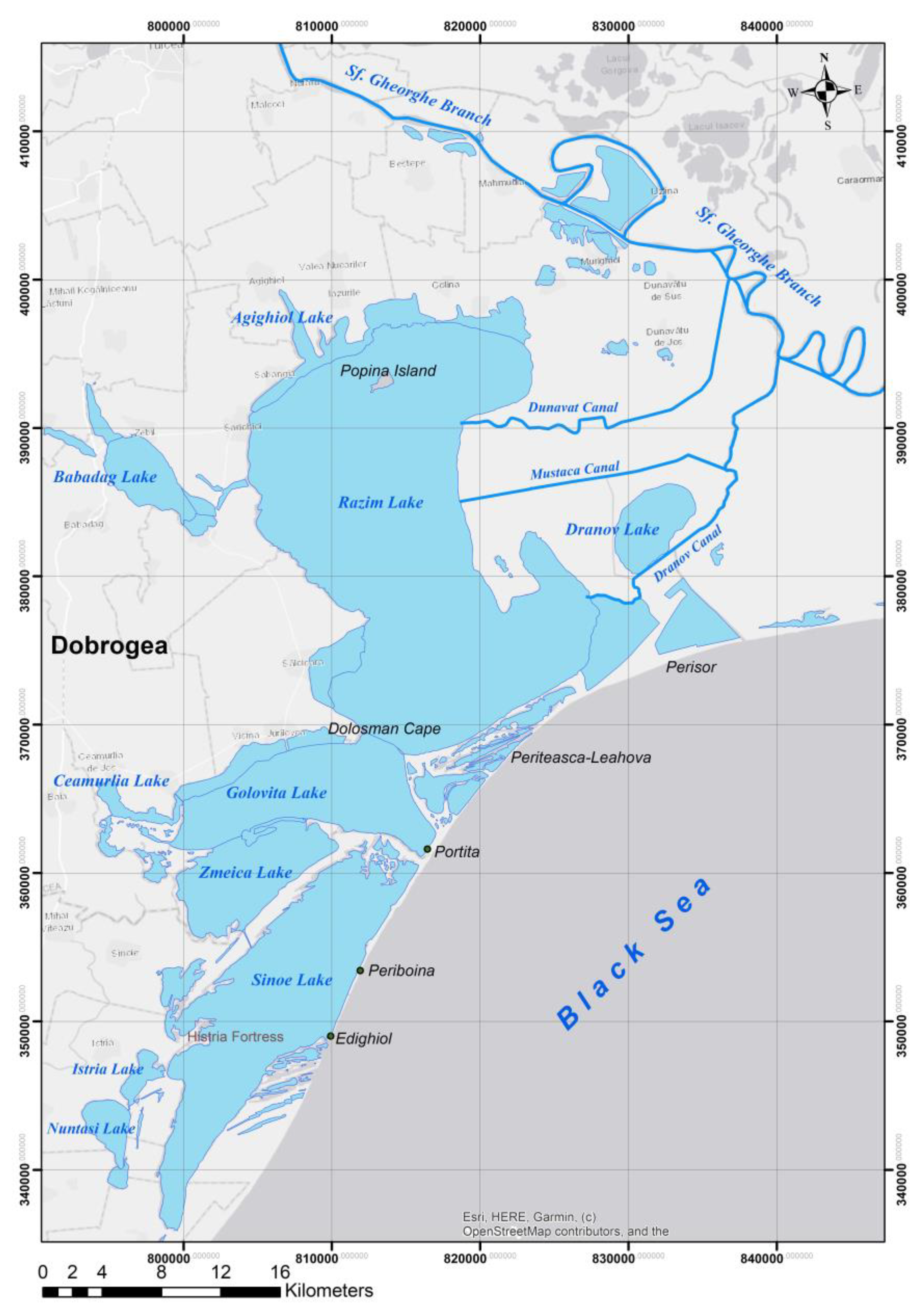
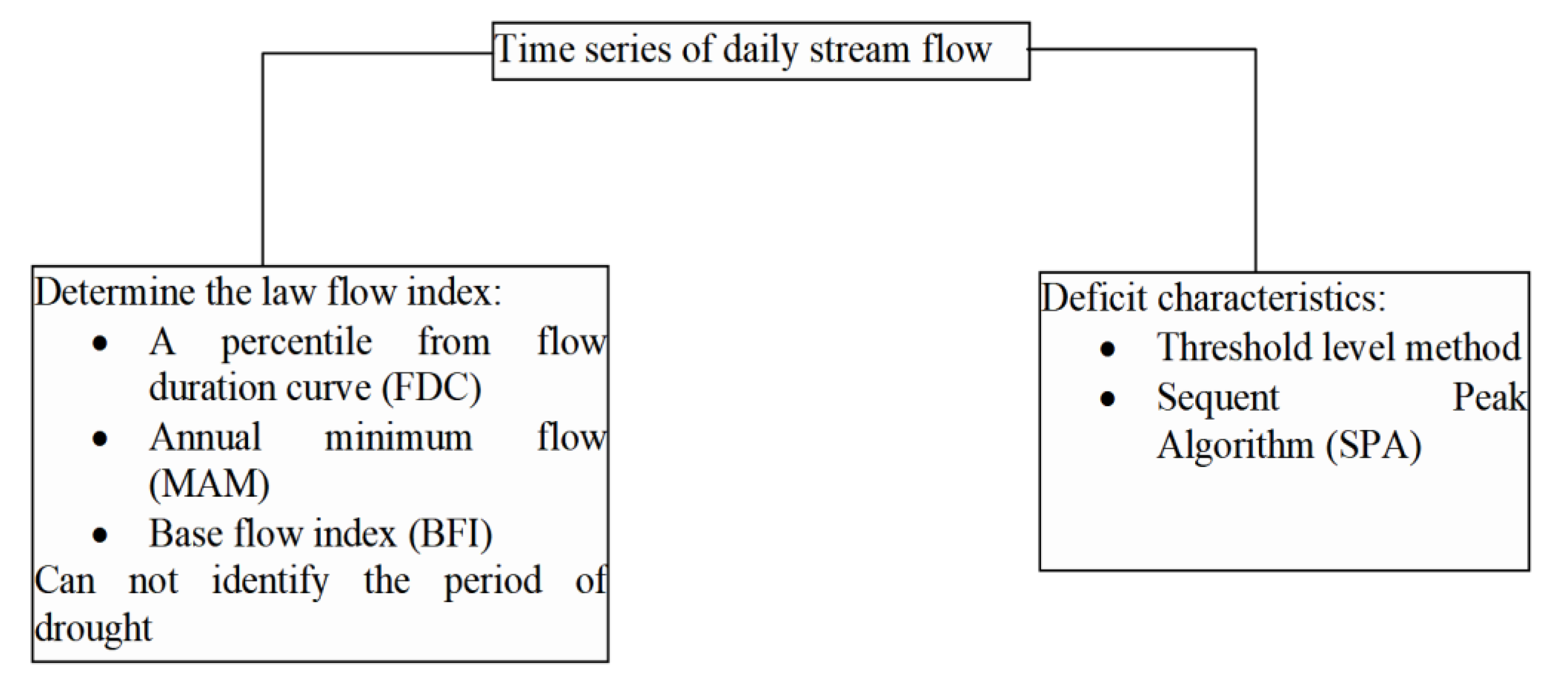
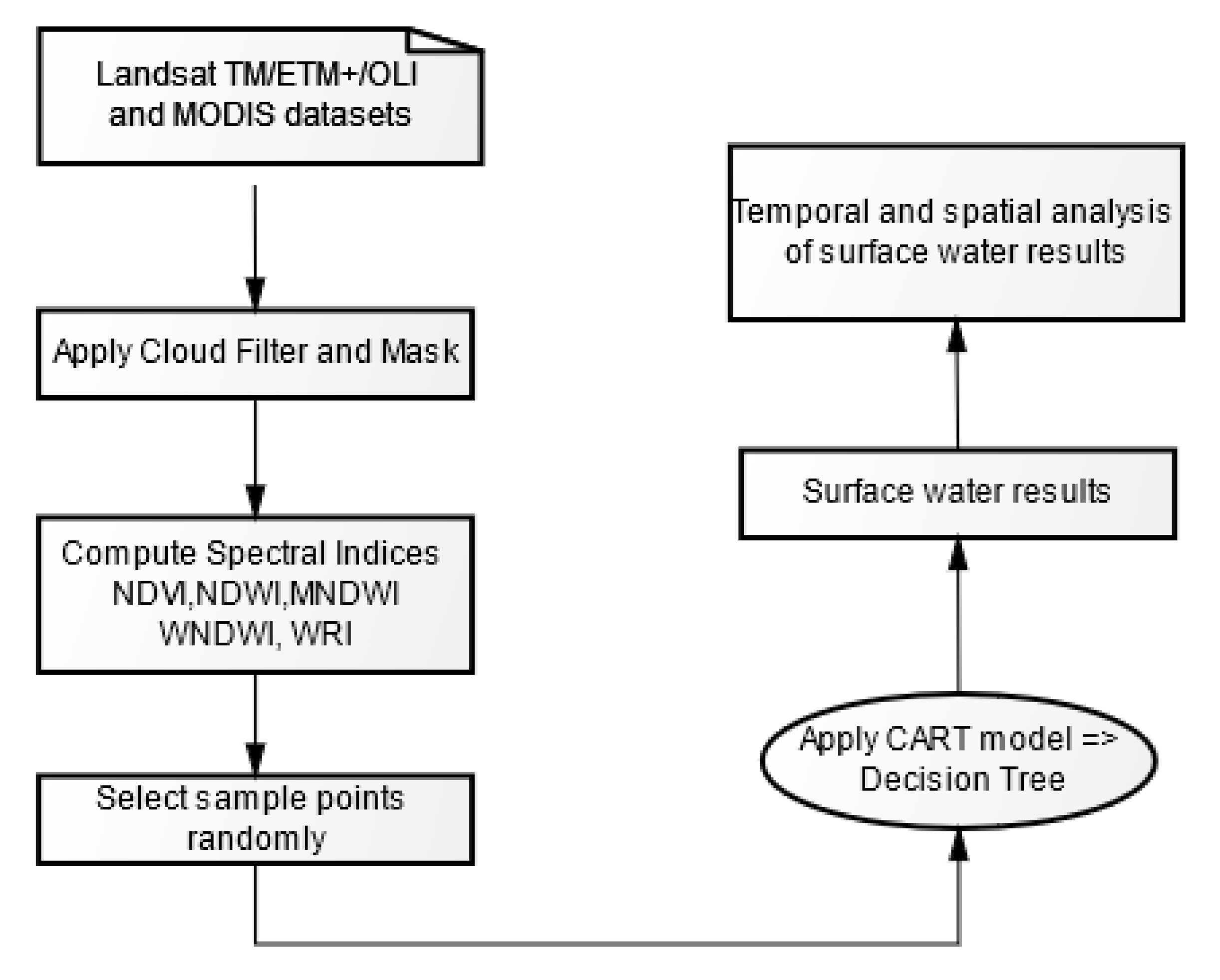
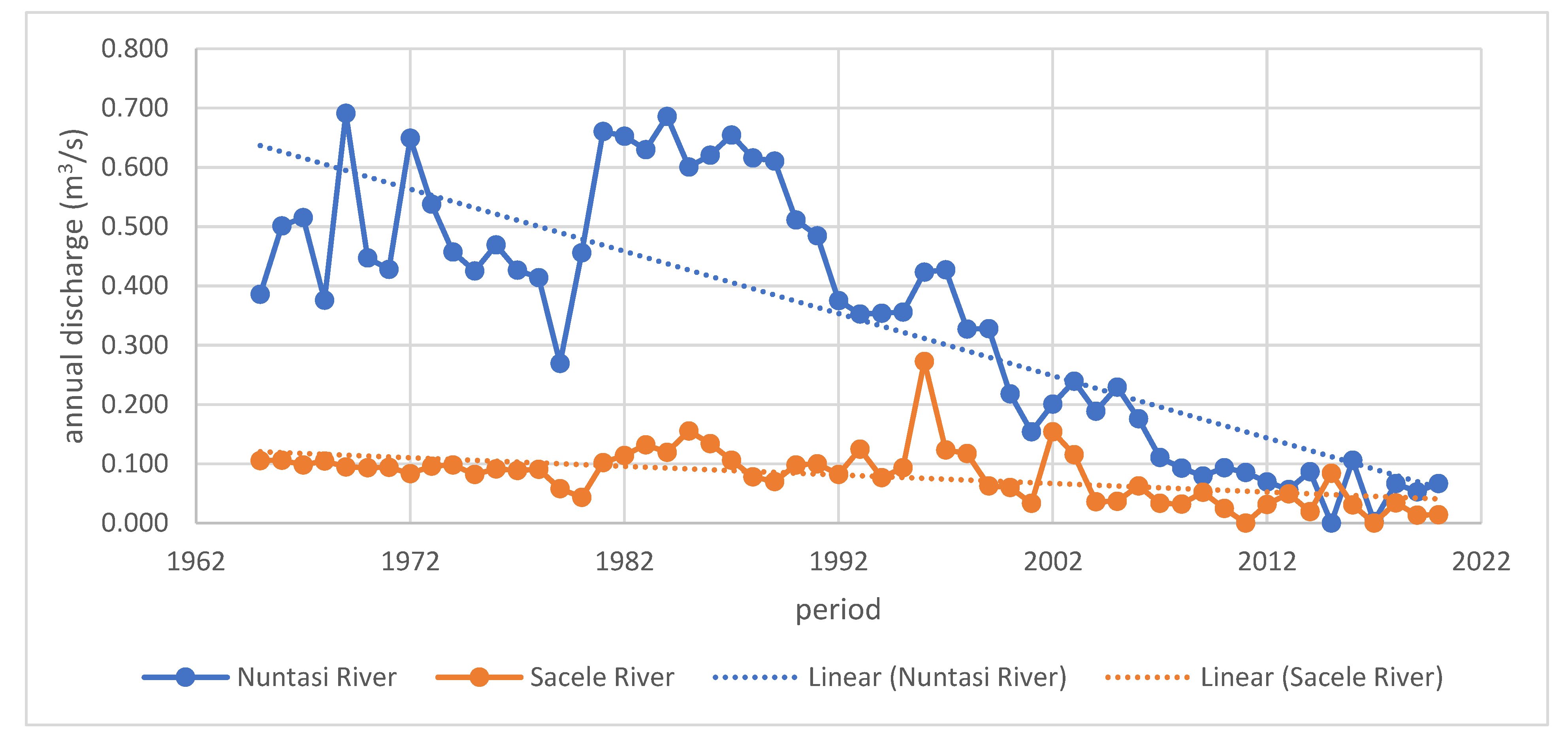
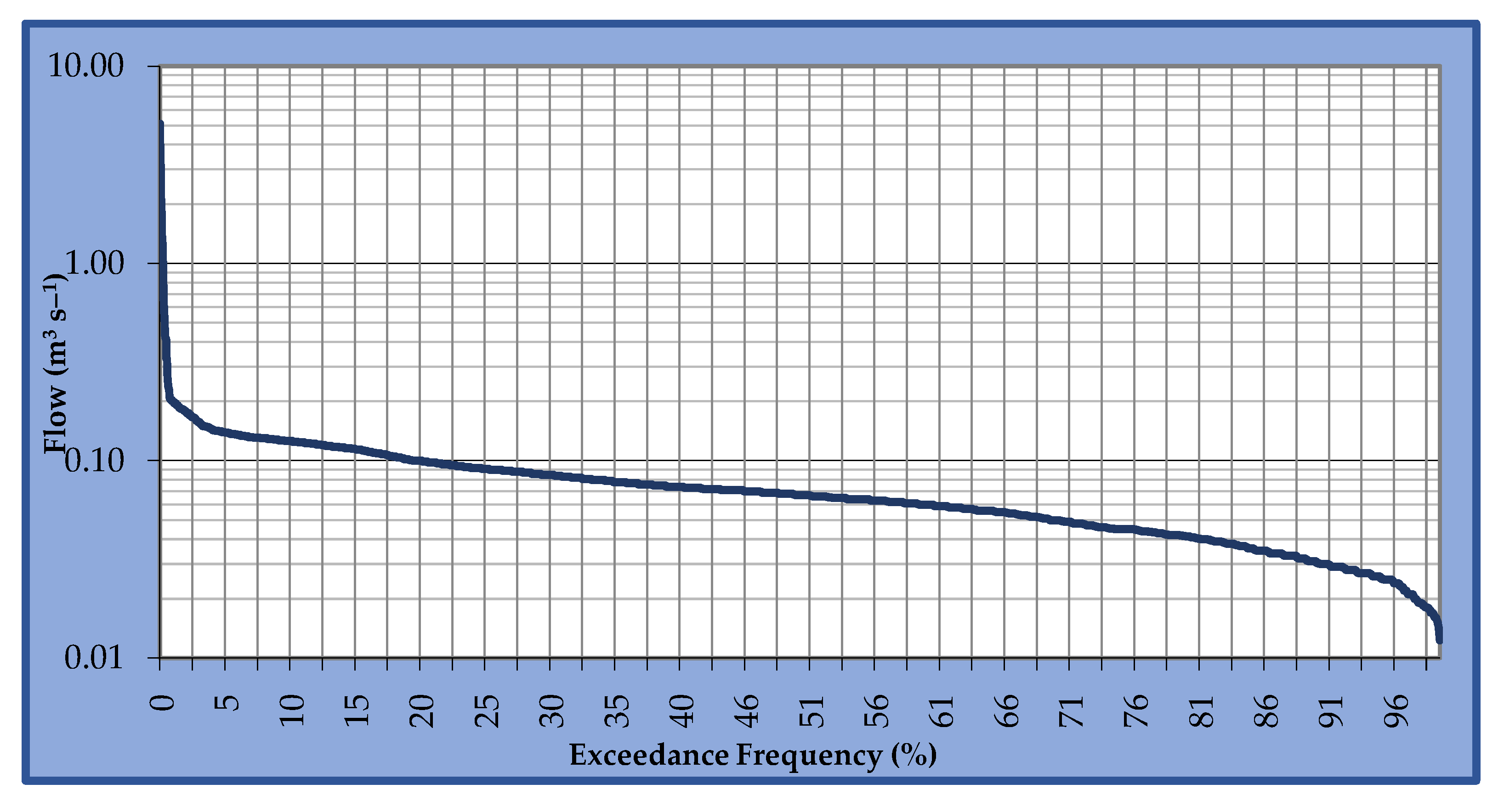
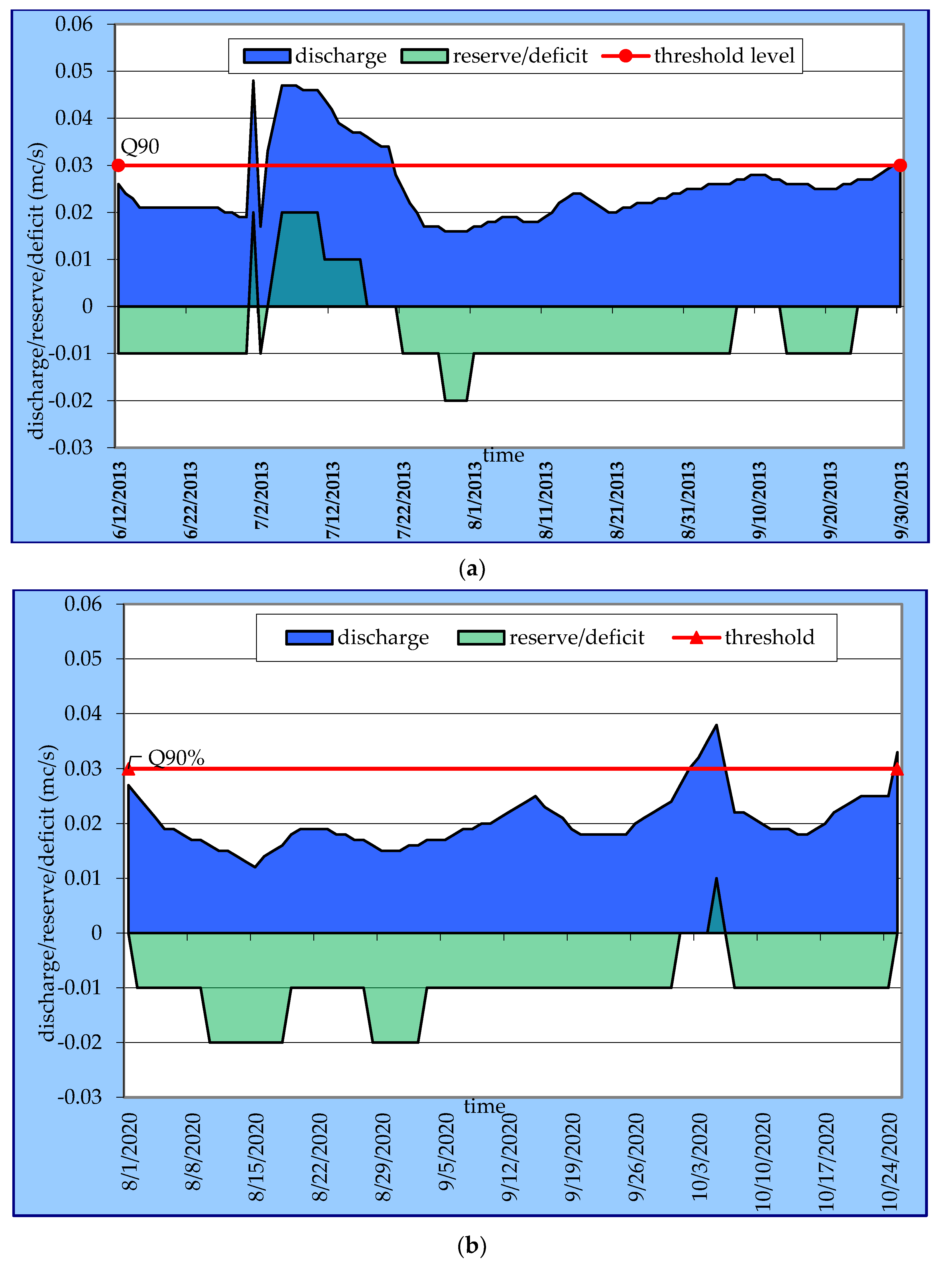
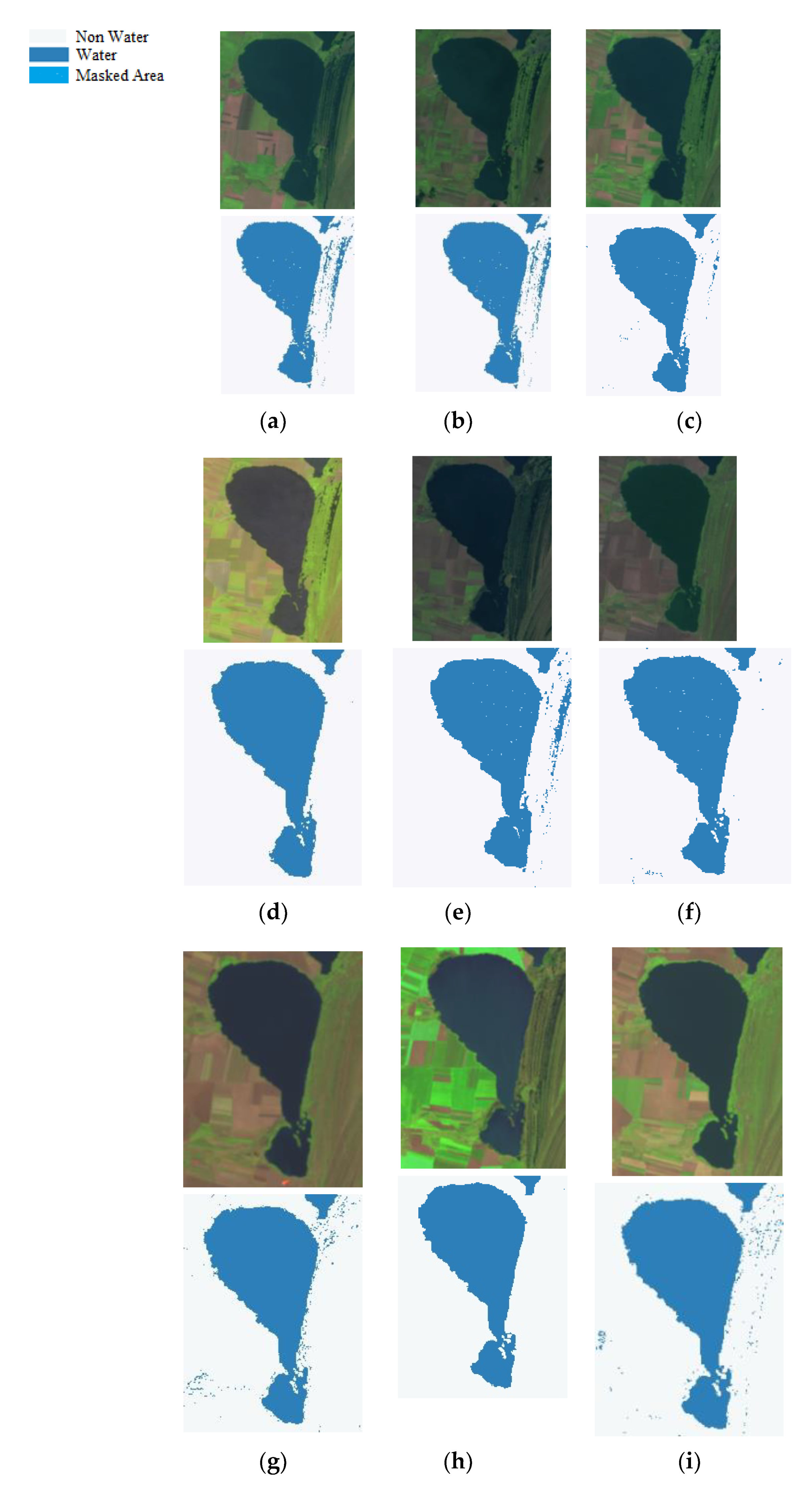
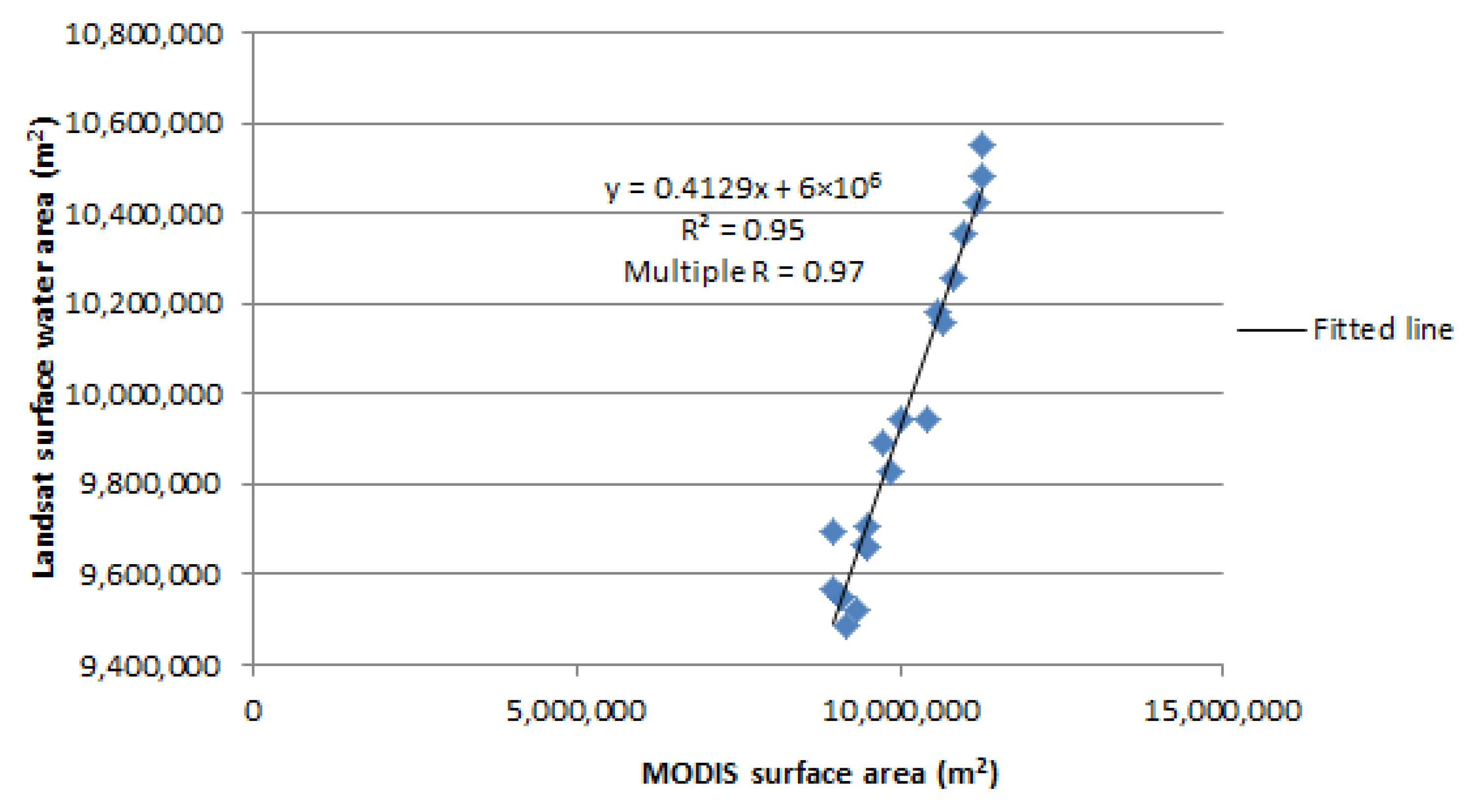

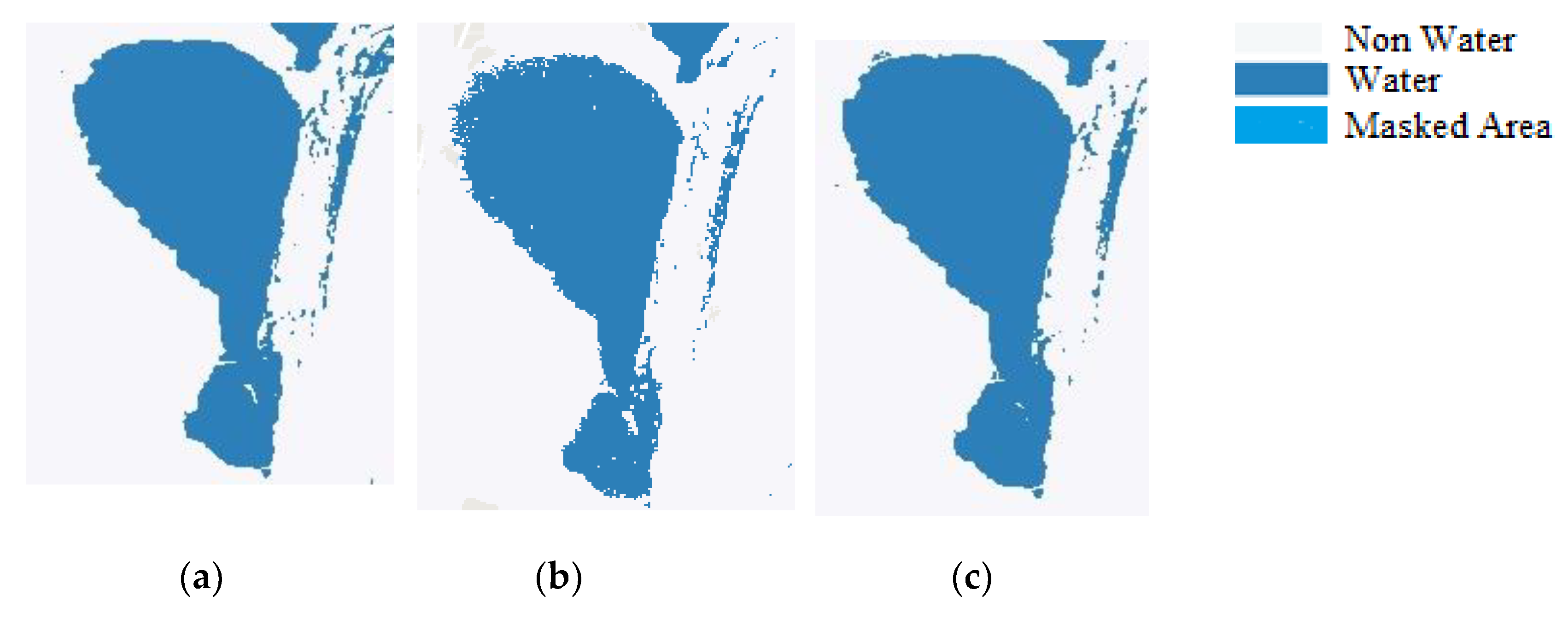
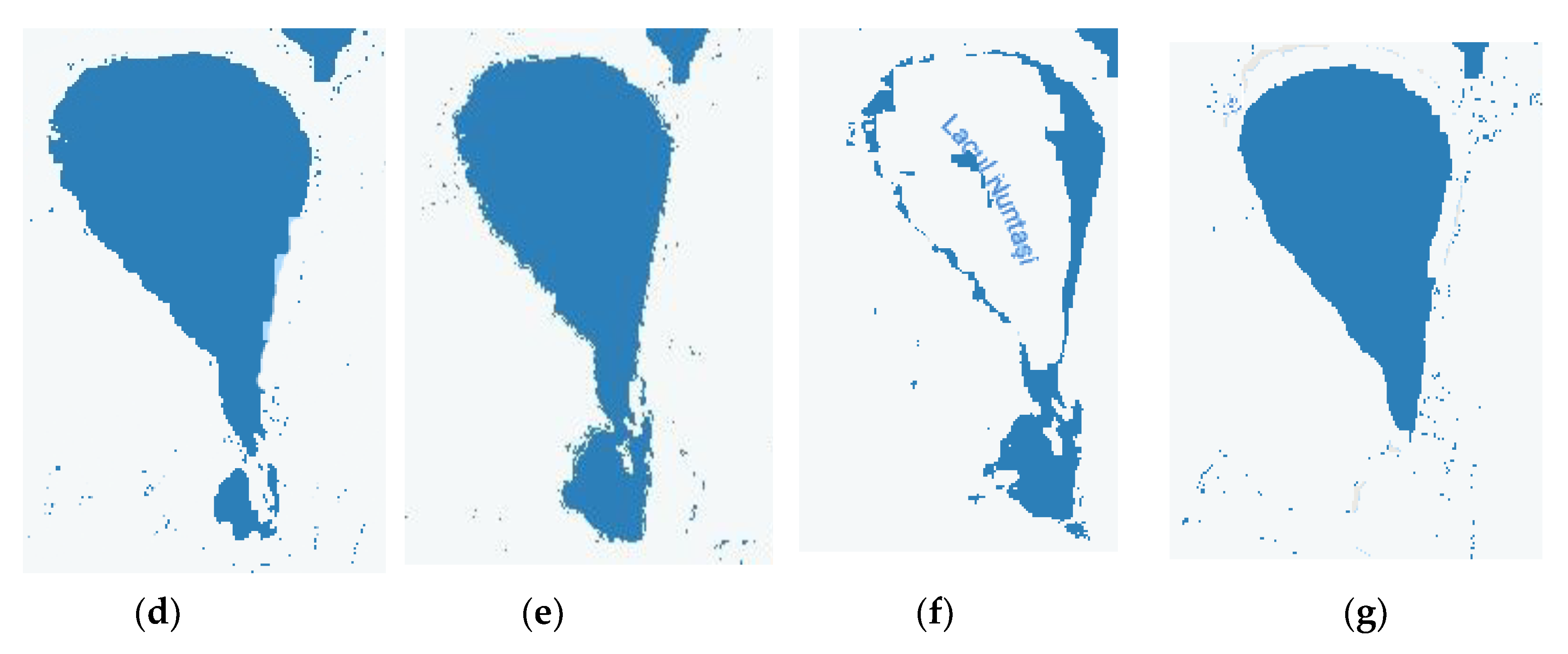
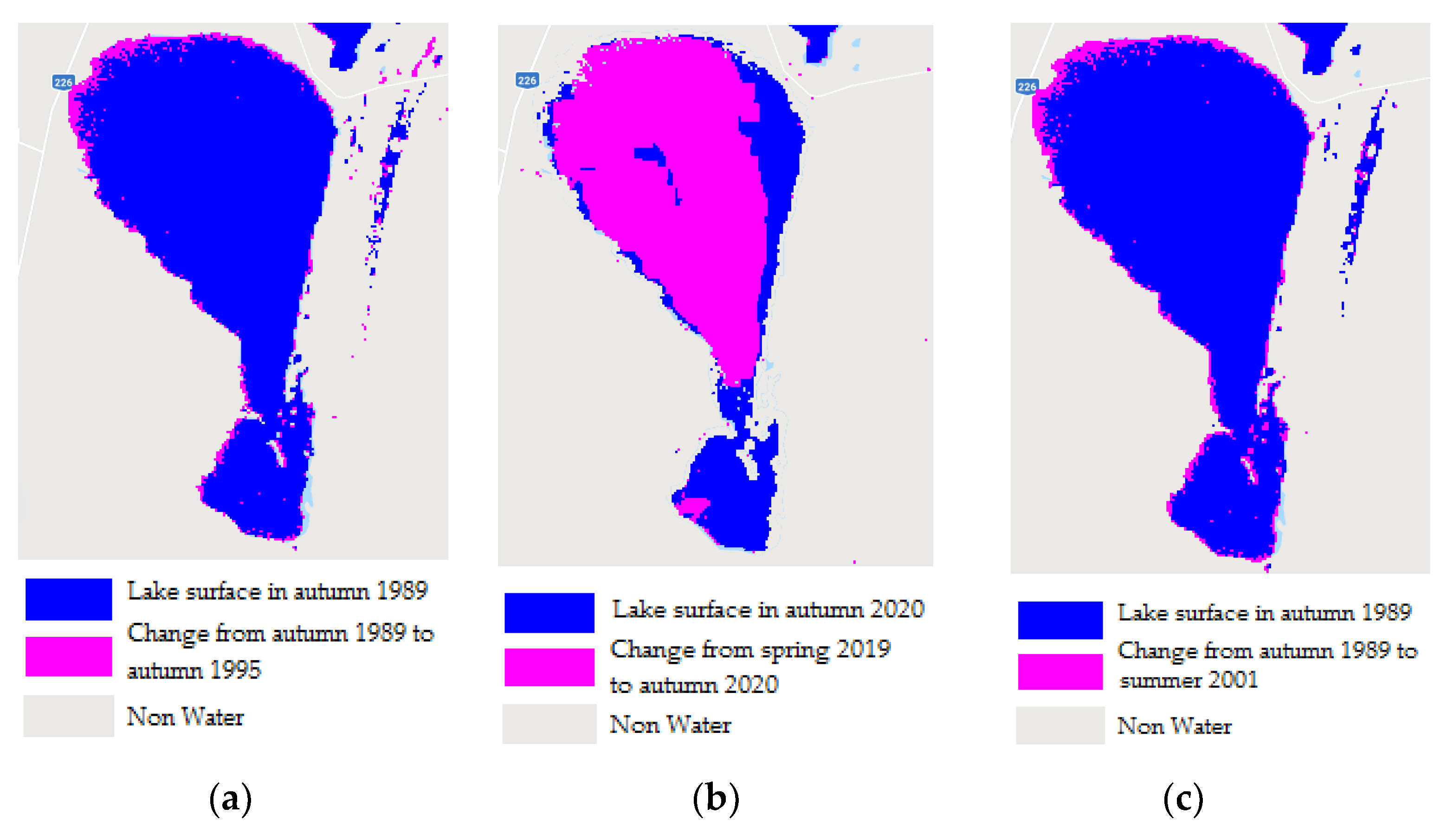
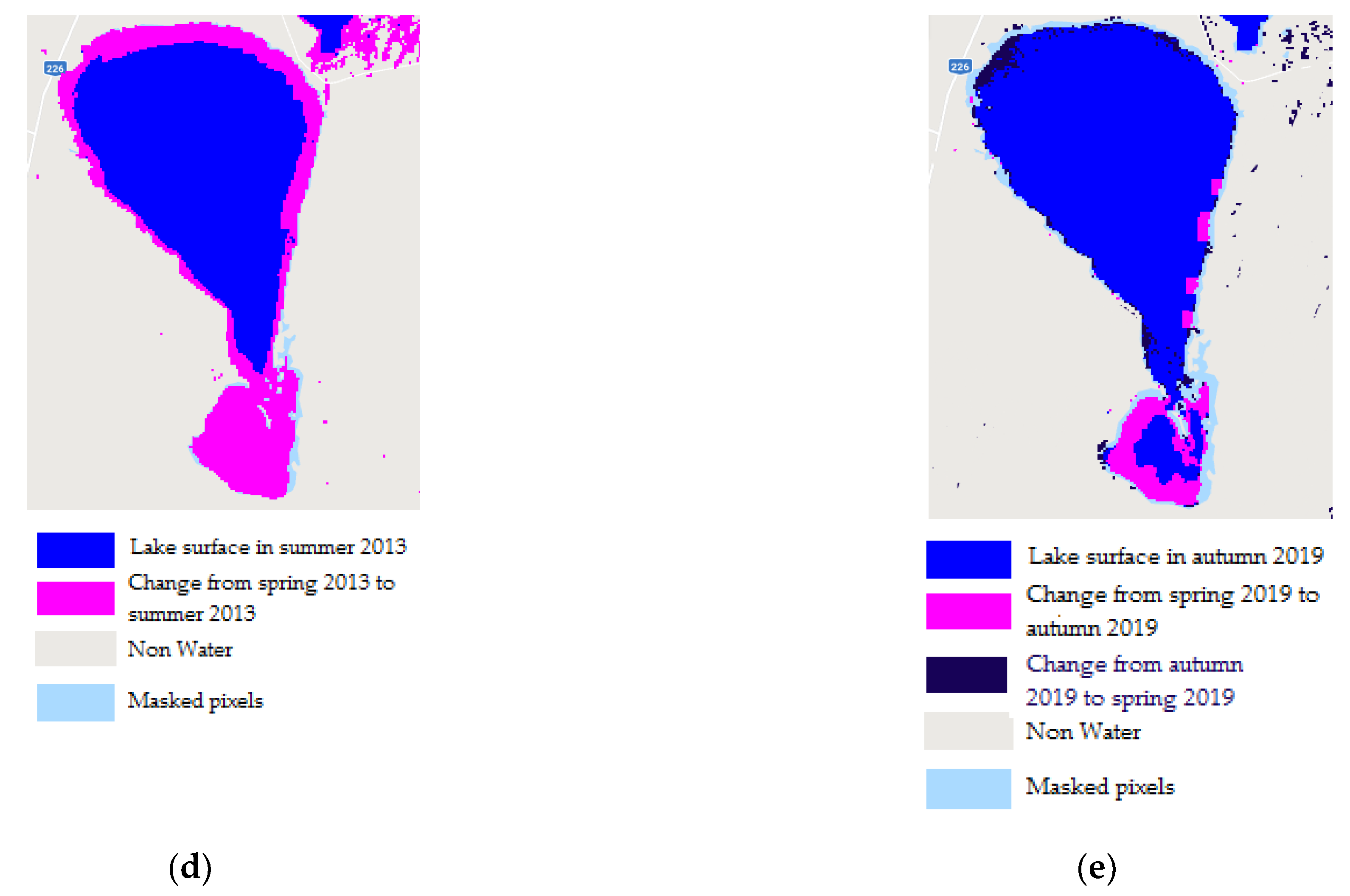
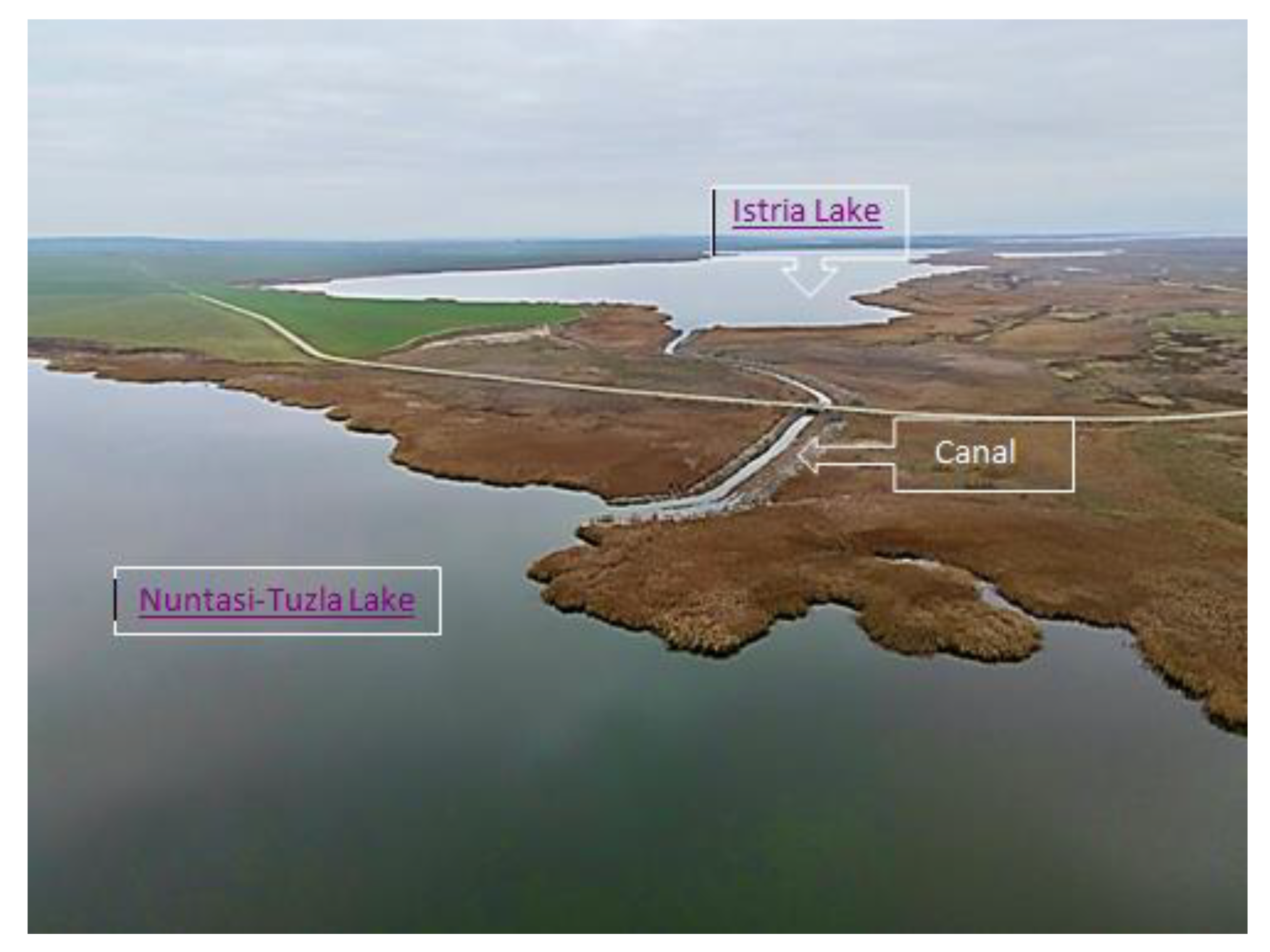
| Period | Spring | Summer | Autumn |
|---|---|---|---|
| 1984–1999 | 15 | 50 | 25 |
| 2000–2012 | |||
| 2000–31 May 2003 | 9 | 8 | 6 |
| 1 June 2003–2011 | 11 | 29 | 13 |
| 2013–2021 | 19 | 27 | 21 |
| RSI | Formula | Observation |
|---|---|---|
| NDVI | NDVI = (NIR − Red)/(NIR + Red) | Water has negative value |
| NDWI | NDWI = (Green − NIR)/(Green + NIR) | Water has positive value |
| MNDWI | MNDWI = (Green − MIR)/(Green + MIR) | Water has positive value |
| WNDWI | WNDWI = (Green – a ∙ NIR − (1 − a) ∙ SWIR)/(Green + a ∙ NIR + (1 − a) ∙ SWIR) | a [0;1] 1 |
| WRI | WRI = (Green + Red)/(NIR + MIR) | Water is >1 |
| Data | Satellite | Date | Cloud Cover (%) |
|---|---|---|---|
| D1 | Landsat 5 TM | 16 July 1988 | 2.00 |
| D2 | Landsat 5 TM | 3 September1994 | 4.00 |
| D3 | Landsat 5 TM | 28 May 1999 | 14.00 |
| D4 | Landsat 7 ETM+ | 7 June 2000 | 0.00 |
| D5 | Landsat 5 TM | 22 March 2004 | 0.00 |
| D6 | Landsat 5 TM | 18 September 2011 | 3.00 |
| D7 | Landsat 8 OLI | 10 September 2014 | 10.30 |
| D8 | Landsat 8 OLI | 08 May 2015 | 0.83 |
| D9 | Landsat 8 OLI | 29 July 2016 | 1.16 |
| Hydrometric Station | Subseries Period | Average (m3/s) | Observation |
|---|---|---|---|
| Nuntasi | 1965–1980 | 0.466 | hydraulic work construction and irrigation system operation |
| 1981–1989 | 0.637 | ||
| 1990–1997 | 0.410 | gradual disrupting of irrigation system | |
| 1998–2006 | 0.229 | ||
| 2007–2020 | 0.069 | ||
| Sacele | 1965–1996 | 0.103 | |
| 1997–2003 | 0.095 | id. | |
| 2004–2020 | 0.033 |
| Hydrometric Station | EFQ (%) | Qo (m3 s−1) |
|---|---|---|
| Nuntasi | 95 | 0.03 |
| 90 | 0.03 | |
| 80 | 0.04 | |
| 75 | 0.05 | |
| Sacele | 95 | 0.01 |
| 90 | 0.01 | |
| 80 | 0.02 | |
| 75 | 0.02 |
| Date Start | Date End | Length Period (Days) |
|---|---|---|
| 7/20/2008 | 7/22/2008 | 3 |
| 9/28/2011 | 9/30/2011 | 3 |
| 9/27/2012 | 9/29/2012 | 3 |
| 6/13/2013 | 6/30/2013 | 18 |
| 7/2/2013 | 7/2/2013 | 1 |
| 7/23/2013 | 8/30/2013 | 39 |
| 8/15/2019 | 8/16/2019 | 2 |
| 8/29/2019 | 9/1/2019 | 4 |
| 8/3/2020 | 9/14/2020 | 43 |
| 9/16/2020 | 9/30/2020 | 15 |
| 10/7/2020 | 10/20/2020 | 14 |
| Data No. | Class | UA (%) | PA (%) | OA (%) | Kappa |
|---|---|---|---|---|---|
| D1 | Water | 95.74 | 100.00 | 98.21 | 0.96 |
| Non-Water | 100.00 | 97.31 | |||
| D2 | Water | 100.00 | 98.11 | 99.09 | 0.98 |
| Non-Water | 98.27 | 100.00 | |||
| D3 | Water | 98.36 | 100.00 | 99.01 | 0.98 |
| Non-Water | 100.00 | 97.61 | |||
| D4 | Water | 96.77 | 100.00 | 98.03 | 0.96 |
| Non-Water | 100.00 | 95.23 | |||
| D5 | Water | 100.00 | 98.36 | 99.09 | 0.98 |
| Non-Water | 98.03 | 100.00 | |||
| D6 | Water | 98.50 | 100.00 | 99.06 | 0.98 |
| Non-Water | 100.00 | 98.00 | |||
| D7 | Water | 98.07 | 100.00 | 99.03 | 0.98 |
| Non-Water | 100.00 | 98.11 | |||
| D8 | Water | 98.21 | 100.00 | 99.03 | 0.98 |
| Non-Water | 100.00 | 97.95 | |||
| D9 | Water | 97.95 | 100.00 | 99.09 | 0.98 |
| Non-Water | 100.00 | 98.38 |
| Date | Class | UA (%) | PA (%) | OA (%) | Kappa |
|---|---|---|---|---|---|
| 20 August 2012 | Water | 95.75 | 95.55 | 95.74 | 0.91 |
| Non-Water | 95.94 | 95.91 | |||
| 23 September 2012 | Water | 96.07 | 98.00 | 96.66 | 0.94 |
| Non-Water | 97.91 | 95.91 |
Publisher’s Note: MDPI stays neutral with regard to jurisdictional claims in published maps and institutional affiliations. |
© 2022 by the authors. Licensee MDPI, Basel, Switzerland. This article is an open access article distributed under the terms and conditions of the Creative Commons Attribution (CC BY) license (https://creativecommons.org/licenses/by/4.0/).
Share and Cite
Șerban, C.; Maftei, C.; Dobrică, G. Surface Water Change Detection via Water Indices and Predictive Modeling Using Remote Sensing Imagery: A Case Study of Nuntasi-Tuzla Lake, Romania. Water 2022, 14, 556. https://doi.org/10.3390/w14040556
Șerban C, Maftei C, Dobrică G. Surface Water Change Detection via Water Indices and Predictive Modeling Using Remote Sensing Imagery: A Case Study of Nuntasi-Tuzla Lake, Romania. Water. 2022; 14(4):556. https://doi.org/10.3390/w14040556
Chicago/Turabian StyleȘerban, Cristina, Carmen Maftei, and Gabriel Dobrică. 2022. "Surface Water Change Detection via Water Indices and Predictive Modeling Using Remote Sensing Imagery: A Case Study of Nuntasi-Tuzla Lake, Romania" Water 14, no. 4: 556. https://doi.org/10.3390/w14040556
APA StyleȘerban, C., Maftei, C., & Dobrică, G. (2022). Surface Water Change Detection via Water Indices and Predictive Modeling Using Remote Sensing Imagery: A Case Study of Nuntasi-Tuzla Lake, Romania. Water, 14(4), 556. https://doi.org/10.3390/w14040556







